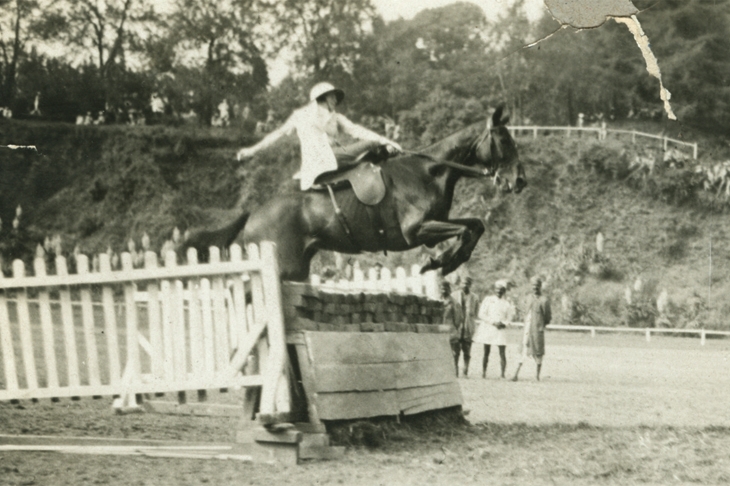These days there are more than 1,000 members of the Side Saddle Association. Well, of course there are. People go to Bisley to shoot muzzle–loaders with black powder instead of modern rifles with laser-sights; people prefer Bugattis to brand-new electric cars. And of course it’s a bit mad. We mustn’t go around criticising things just because they’re mad; that would leave us all terribly vulnerable.
I once rode side-saddle with three members of the King’s Troop, Royal Horse Artillery. No, seriously. They were all saddlers, fascinated by this unexplored aspect of their craft. I joined them at an event hosted by the SSA, expecting to find it horrible and unnatural, and it was nothing of the kind.
Because you’re not actually sideways. Your shoulders are above your hips and square-on to the horse, just like normal. True, your right foot is more or less on your left knee, but I often sit like that. The point is that you can control your horse. If you can ride, it’s easy.
I’d always thought that a side-saddle was an instrument of subjugation and that its revival was like bringing back the chastity belt. That’s got it precisely upside-down. The invention of the two-pommel side-saddle in the 1830s was a liberation: at last a woman could take control of her horse and gallop and jump with the best.
It’s not remotely insecure. It’s actually harder to fall off a side-saddle than a conventional one because your right leg is anchored. It allowed women to hunt, to compete and to ride round the countryside without needing someone to lead the horse. Queen Victoria was nuts for it when she was young; so was Florence Nightingale. This was freedom.
Before the invention of the side-saddle, women just sat sideways, perched awkwardly, twisted, precariously balanced and unable to control their mount. The greatest technological advance they knew was a little plank – the planchette — to rest their feet on. With the side-saddle, women entered the kingdom of the horse, seized it from men and made it their own. These days women dominate the horsey world, to the extent that many people think riding horses is effeminate — though best not tell the King’s Troop.
Even when riding astride became acceptable for women, ladies rode side-saddle. The Radletts in Nancy Mitford despise Lavender Davis as a rider astride. Side-saddle was never a lost skill, just mislaid during the second world war. But the eventual revival was inevitable, and the SSA was formed in 1974.
It continues to grow. You can buy new side-saddles but most riders use an old one: these change hands for around £2,000. And there’s a lively market for the clothes, because there’s no point in riding side-saddle in your old jods and a Puffa jacket.
It reflects a trend. Horsey girls are going back to horses in maturity, seeking ways of enjoying horses in ways that fit in with domestic life, available funds and available courage. Not everyone wants to go tear-arsing across country nel mezzo del cammin.
No doubt it helps that the side-saddle gear is great. And sexy. You balance on a horse by sticking your chest out, and a riding habit is cut to emphasise this. The skirt must give freedom of movement to the legs, and the way it hangs sets off the limbs of both riders and horses.
Check out the 18th-century painting by Joseph Wright of Mr and Mrs Coltman: Mrs C side-saddle on her horse, Mr C leaning nonchalantly against her splayed thighs: a subtly erotic picture that seems to hint that the two have come to their morning ride after a particularly good gallop before they got up.
And Clarissa Dawson, side-saddle rider of the year 1997, looked pretty wonderful as she sat on her dappled grey in a riding habit, top-hat, Edwardian cut-away jacket, waistcoat, high stock and veil. ‘The really difficult thing is to drink a gin and tonic through the veil,’ she said. ‘The only answer is to sink all pride and use a straw.’
These days there are women riding side-saddle at all the best hunts. You need a taste for excitement and for cutting a dash to get away with it. But there are less dangerous options at all levels of competence; the annual National Side Saddle Show has more than 70 classes.
So yes, it’s about dressing up and elegance and nostalgia but above all it’s about horses: because for some people the bloody things are a necessity. Side-saddle is just one more way of having fun with a horse, and any way you do that without harming the horse is OK by me.






Comments